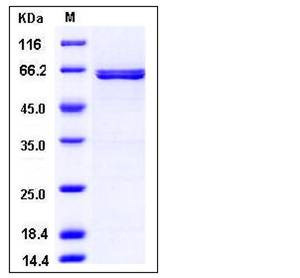Human AIM2 Protein (GST Tag)
PYHIN4
- 100ug (NPP1878) Please inquiry
| Catalog Number | P11654-H09B |
|---|---|
| Organism Species | Human |
| Host | Baculovirus-Insect Cells |
| Synonyms | PYHIN4 |
| Molecular Weight | The recombinant human AIM2/GST chimera consists of 567 amino acids and predicts a molecular mass of 65.2 kDa as estimated in SDS-PAGE under reducing conditions. |
| predicted N | Met |
| SDS-PAGE |  |
| Purity | > 95 % as determined by SDS-PAGE |
| Protein Construction | A DNA sequence encoding the human AIM2 (NP_004824.1) (Met 1-Thr 343) was fused with the GST tag at the N-terminus. |
| Bio-activity | Measured by its ability to inhibit the proliferation of MCF7 human breast adenocarcinoma cells(Karey, K.P. et al. (1988) Cancer Research 48:4083.). The ED50 for this effect is typically 4-7 μg/ml. |
| Research Area | Cancer |Oncoprotein & suppressor & biomarker |Tumor biomarker |Tumor Suppressor |Other in Tumor suppressor |
| Formulation | Lyophilized from sterile 50mM Tris, 1M NaCl, 0.5mM PMSF, 5mM GSH, pH 8.0 1. Normally 5 % - 8 % trehalose, mannitol and 0.01% Tween80 are added as protectants before lyophilization. Specific concentrations are included in the hardcopy of COA. |
| Background | AIM2, Absent In Melanoma 2 is a member of the interferon-inducible HIN-200 protein family that contains an amino-terminal pyrin domain and a carboxy-terminal oligonucleotide/oligosaccharide-binding domain, senses cytoplasmic DNA by means of its oligonucleotide/oligosaccharide-binding domain and interacts with ASC (apoptosis-associated speck-like protein containing a CARD) through its pyrin domain to activate caspase-1. In response to foreign cytoplasmic DNA, AIM2 forms an inflammasome, resulting in caspase activation in inflammatory cells. It had been pointed to a role of AIM2 function in both inflammation and cancer. AIM-2 antigen is expressed in a wide variety of tumor types, including neuroectodermal tumors, as well as breast, ovarian and colon carcinomas. AIM-2 could be used as a tumor antigen target for monitoring vaccine trials or to develop antigen specific active immunotherapy for glioma patients. |
| Reference |
